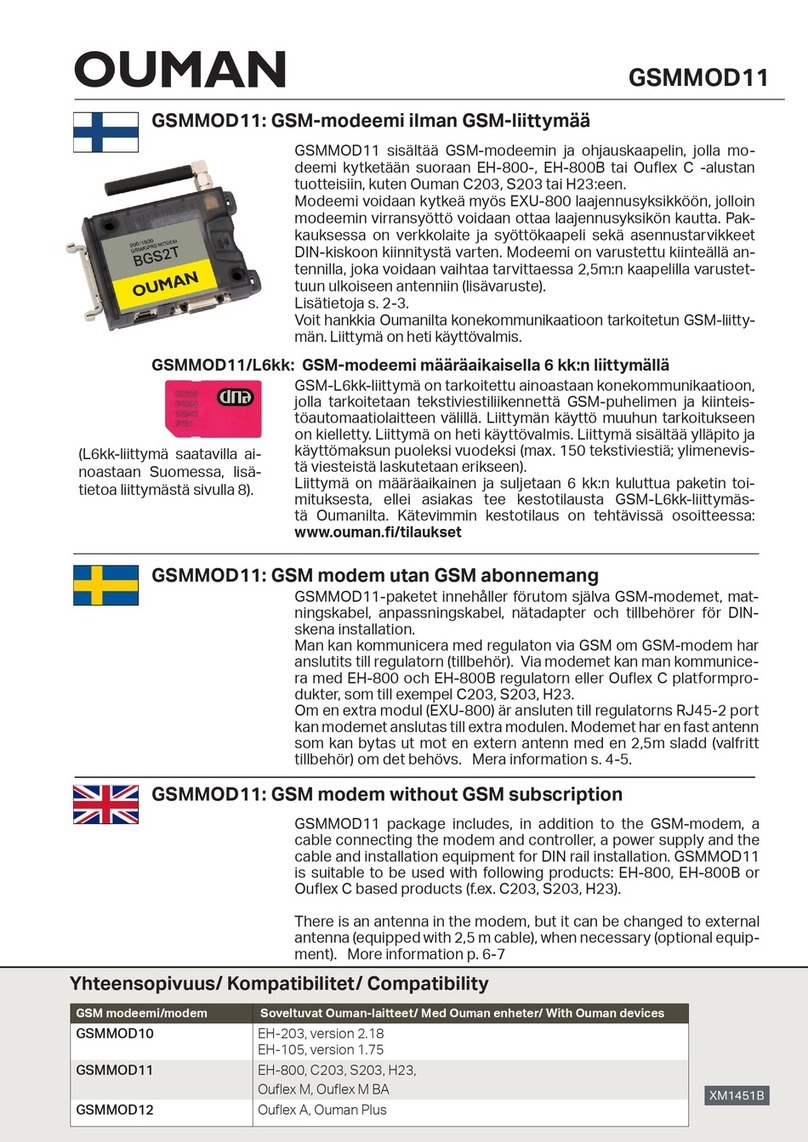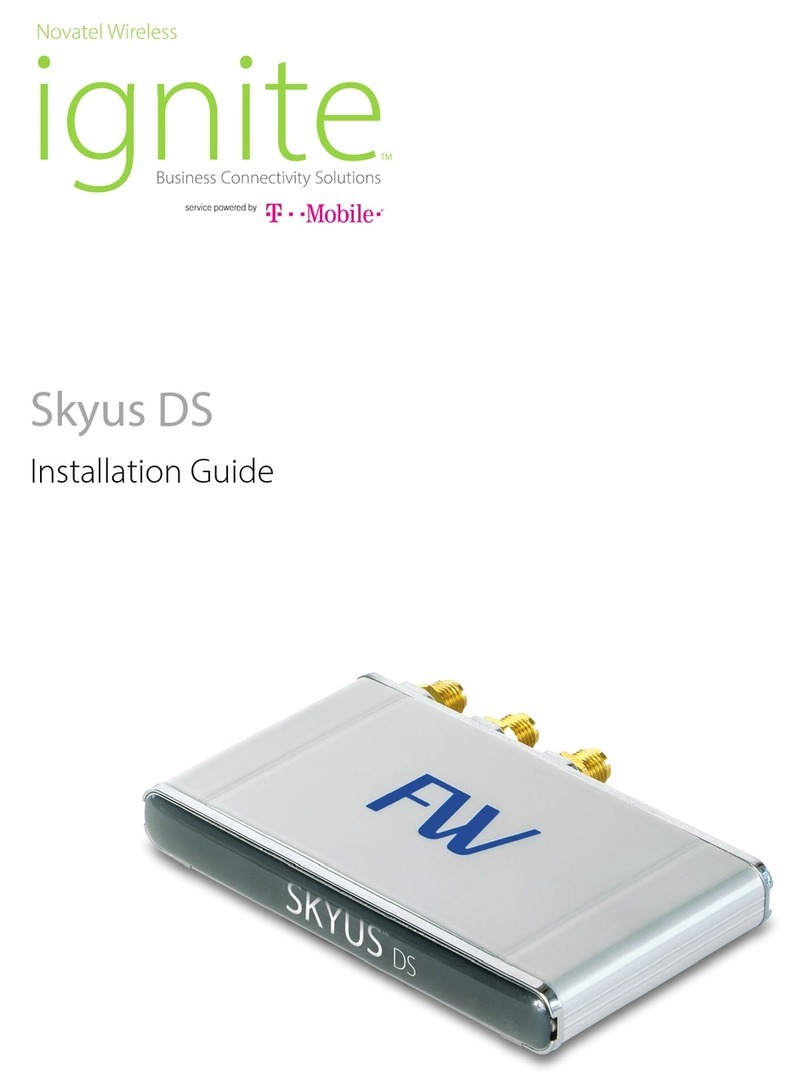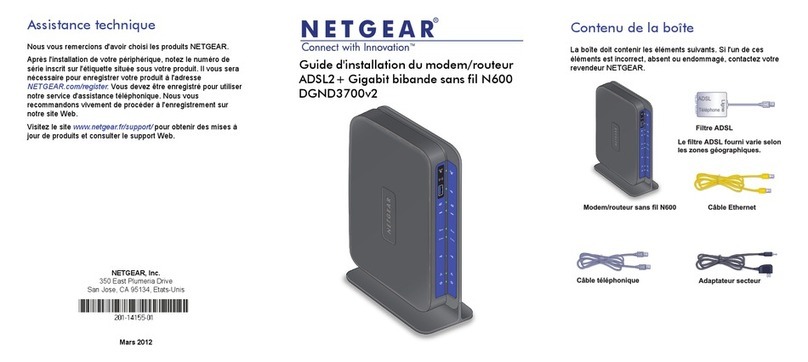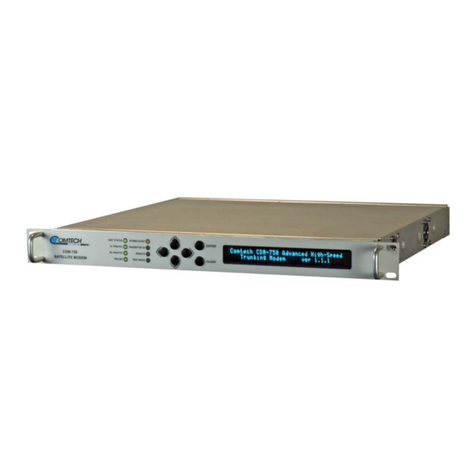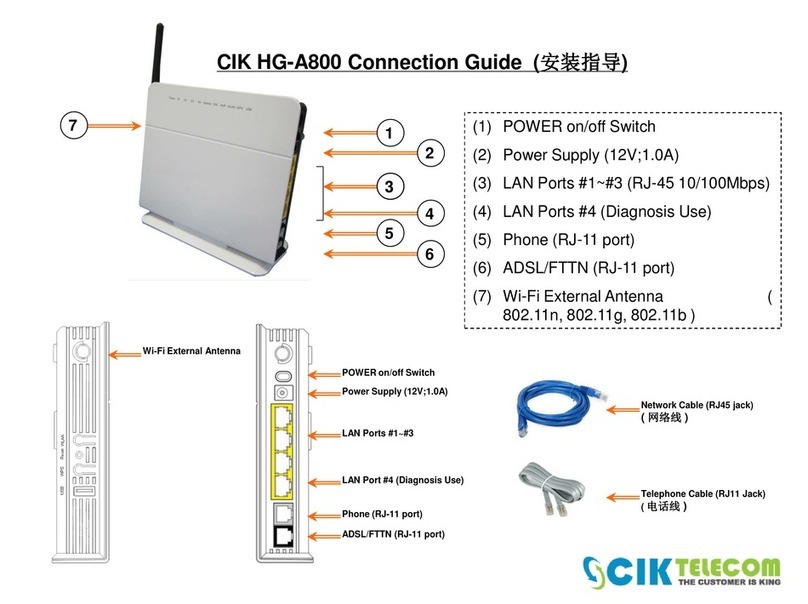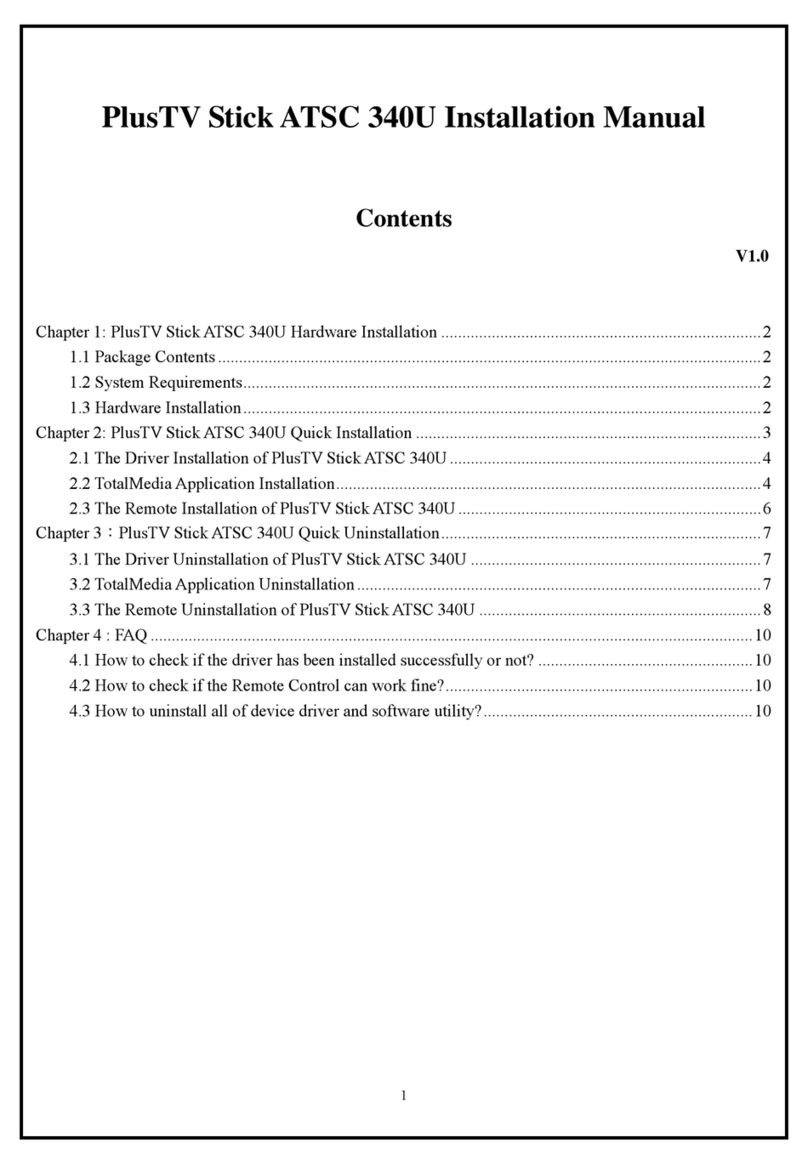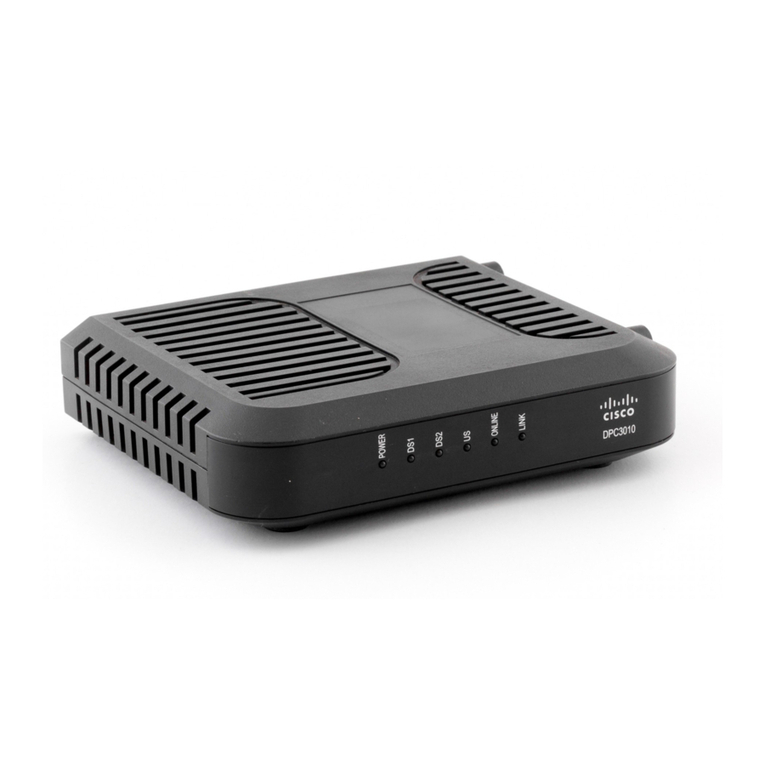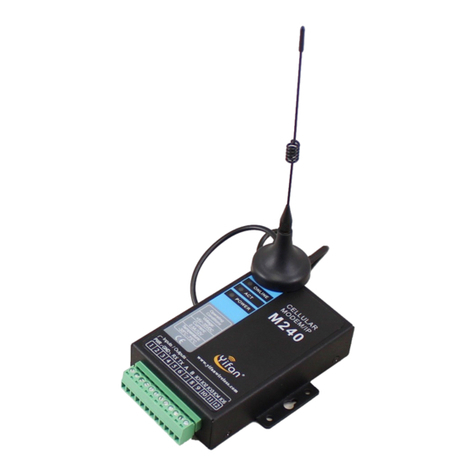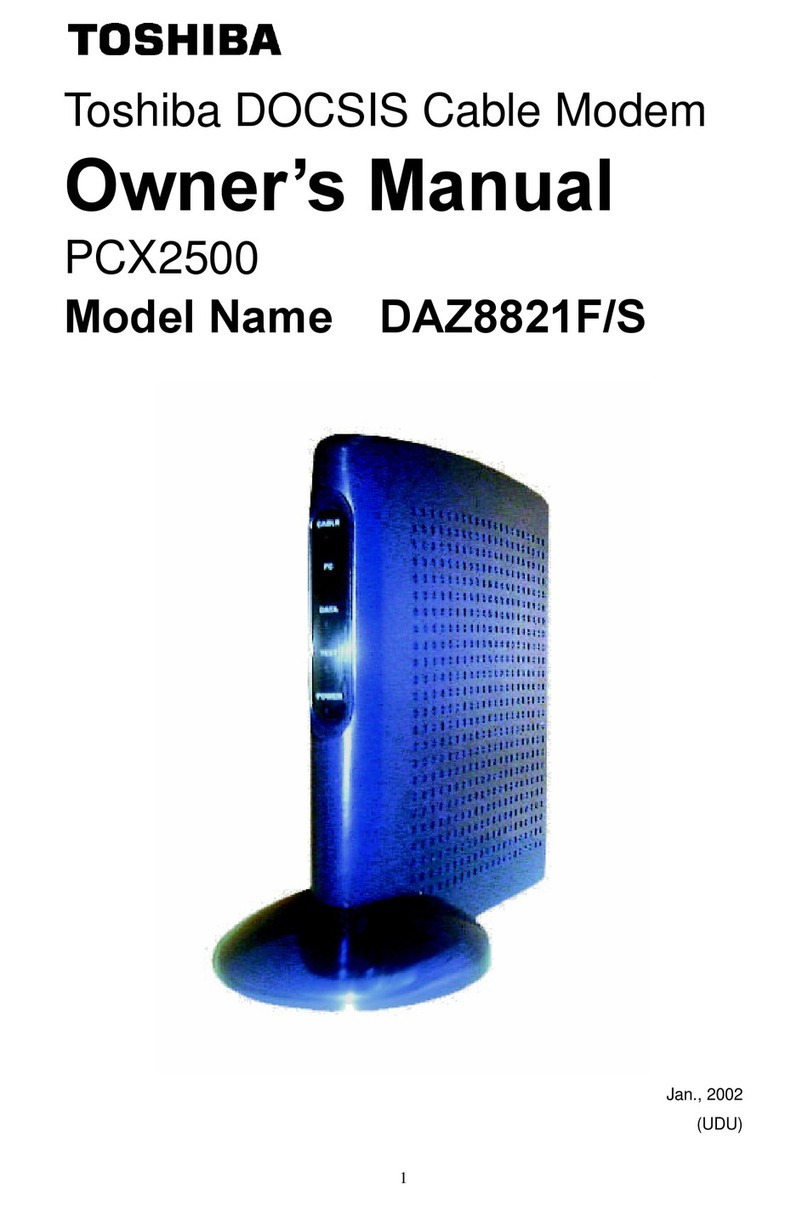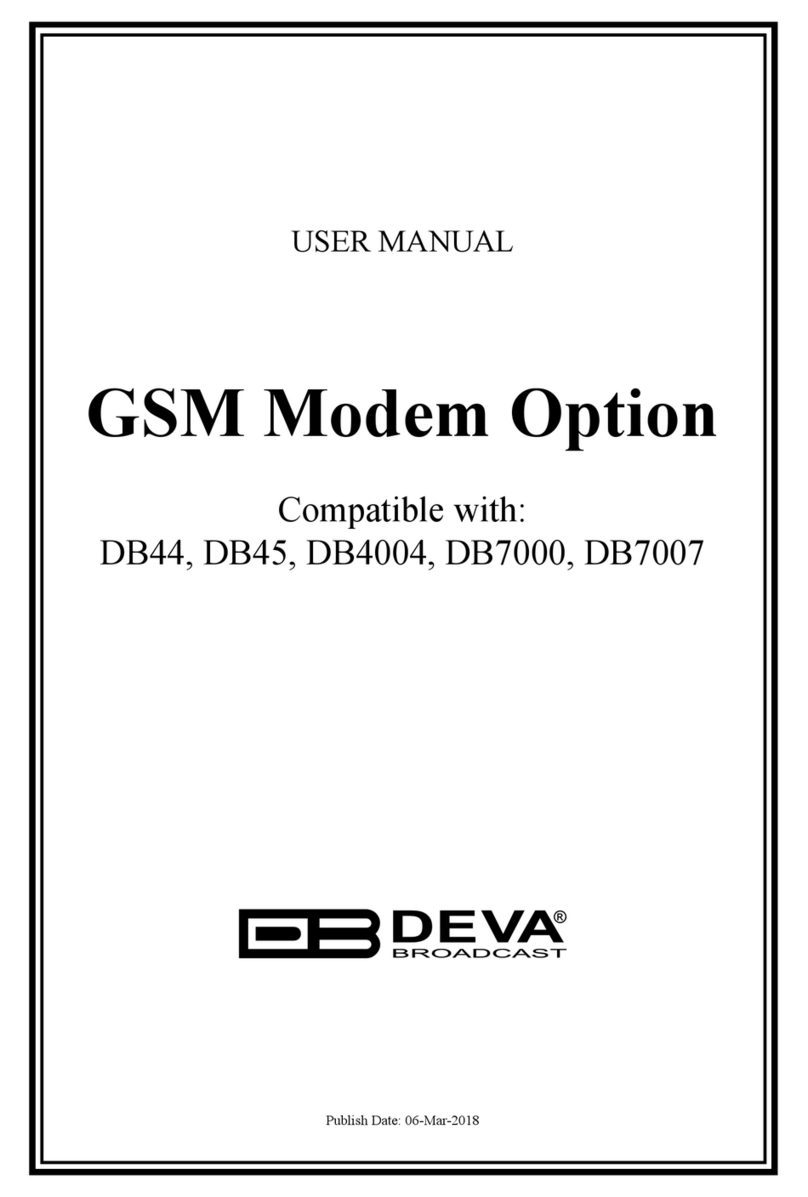TC Communications TC1710 User manual

Notice!
Although every effort has been made to insure that this manual is current
and accurate as of date of publication, no guarantee is given or implied
that this document is error free or accurate with regard to any specifica-
tion. TC Communications, Inc. reserves the right to change or modify
the contents of this manual at any time without prior notification.
TC1710
RS-422, RS-485 (2/4 WIRE)
FIBER OPTIC MODEM
(with Optional Dual Optics)
User's Manual
MODEL:
S/N:
DATE:
© COPYRIGHT 1992-2012. ALL RIGHTS RESERVED.
TC Communications, Inc. 17881 Cartwright Road, Irvine, CA 92614
Tel: (949) 852-1972 Fax: (949) 852-1948 Web Site: www.tccomm.com Email: info@tccomm.com

TC1710 RS-485
(Optional Dual Optics)
User's Manual
Rev. 1.6
−2−
Table of Contents
Chapter 1 - Overview ............................................................................................................... 3
Description .......................................................................................................................................... 3
Electrical Specifications ................................................................................................................... 3
Theory of Two and Four Wire RS-485 Operation .......................................................................... 3
Two and Four Wire RS-485 pin connection diagrams .................................................................. 4
RS-422/RS-485 pin connection diagram ....................................................................................... 4
LEDs, DIP Switches and Connectors .............................................................................................. 5
DIP Switch Functions ........................................................................................................................ 6
Front Panel Switches ........................................................................................................................ 6
SW1 Internal PCB Dip Switches for RS-485 Transition Timer Setup ........................................ 6
RS-485 Transition Timer Setup ....................................................................................................... 7
RS-422 & RS-485 Termination Resistor ......................................................................................... 7
Optical Specifications ....................................................................................................................... 7
RS-485 Signal Cross Reference ..................................................................................................... 7
Optical Redundancy (optional) ........................................................................................................ 8
Dry Contact Alarm Relay ................................................................................................................... 8
Power Supply ...................................................................................................................................... 8
Chapter 2 - Installation ........................................................................................................... 9
Unpacking the Unit ............................................................................................................................ 9
Equipment Location .......................................................................................................................... 9
Installation Procedure Summary ..................................................................................................... 9
Chapter 3 - Troubleshooting ................................................................................................ 11
General .............................................................................................................................................. 1 1
All LEDs are "Off" ............................................................................................................................. 1 1
Alarm LED ......................................................................................................................................... 1 1
Optic Cable Types ............................................................................................................................ 1 1
Calculating the Loss on the Fiber ................................................................................................. 1 1
RS-485 Cable Verification ............................................................................................................... 1 1
Optic Cable Verification .................................................................................................................. 1 2
Chapter 4 - Bench Tests ....................................................................................................... 13
General .............................................................................................................................................. 1 3
Test Equipment Requirements ...................................................................................................... 1 3
Pre-Installation Tests ....................................................................................................................... 1 3
Bench Test With Built-In Signal Generator .................................................................................. 1 4
Chapter 5 - Component Placement ..................................................................................... 15
Chapter 6 - Specifications .................................................................................................... 16
Appendix A............................................................................................................................. 17
DB25 to Winchester (DTE) Adapter Cable (for V.35 interface) ................................................ 1 7
Appendix B............................................................................................................................. 18
DB25 to Winchester (DCE) Adapter Cable (for V.35 interface) ............................................... 1 8
Appendix C ............................................................................................................................ 19
Return Policy .................................................................................................................................... 1 9
Warranty ............................................................................................................................................. 19
Limitation of Liability .......................................................................................................................... 20

TC1710 RS-485
(Optional Dual Optics)
User's Manual
Rev. 1.6
−3−
Chapter 1 - Overview
Description
The TC1710 RS-485 is an economical and dependable fiber optic modem with RS-485 interface (same as
RS-422 with DB25 connector). It is available in either rack mount or stand alone versions; the rack mount
version can be converted to the stand alone version with the addition of a sheet metal box. The TC1710 can
communicate at distances up to 4 km using Multimode optics and up to 80 km using Single Mode optics.
TC1710's design utilizes advanced FPGA (Field Programmable Gate Array) technology to increase reliability
and flexibility.
Electrical Specifications
Interface: RS-485 Async
Data Rates: Up to 10Mbps
Connector: DB25 Female DCE
Theory of Two and Four-Wire RS-485 Operation
Figure 1. Two-Wire RS-485 Logic Diagram
Two-wire RS-485 is a half-duplex operation, which means transmit and receive operations take turns; they
do not function concurrently. From the user’s point-of-view, the channel is in receiving mode when no data
is transmitted from the remote unit. (See Figure 1).
Four-wire RS-485 is a full-duplex operation, which means transmit and receive operations function
concurrently. From the user's point-of-view, both channels are in the receiving or transmitting mode at all
times. (See fFgure 2).
The RS-485 Driver/Receiver transition time is determined by four internal DIP switches (internal SW1) on
the TC1710. The local unit's RS-485 transceiver changes to transmit (Tx) mode upon receiving the first bit
of data from the remote unit. The transition time is the amount of time before the local unit's RS-485
transceiver will revert to the high-impedance receiver mode after the last bit is received fromthe remote unit.
The RS-485 transition time should be set according to Table 1 on page 6.
Figure 2. Four-Wire RS-485 Logic Diagram

TC1710 RS-485
(Optional Dual Optics)
User's Manual
Rev. 1.6
−4−
For RS-422 and RS-485 Four-wire interfaces, pins 2(-) & 14(+) are inputs while pins 3(-) & 16(+) are outputs.
For Two-wire RS-485 interfaces, pins 3(-) & 16(+) are input/outputs.
Ω
Ω
Ω
RS-485 Pin Connections
Figure 3. Two-wire RS-485 Connection/Logic Diagram
Figure 4. Four-wire RS-422/RS-485 Connection/Logic Diagram

TC1710 RS-485
(Optional Dual Optics)
User's Manual
Rev. 1.6
−5−
LEDs, DIP Switches and Connectors
Figure 5. TC1710's Front Panel
1
2
3
4
{
{
{

TC1710 RS-485
(Optional Dual Optics)
User's Manual
Rev. 1.6
−6−
DIP Switch Functions
For troubleshooting purpose, user can conduct remote loopback and local loopback test. TC1710 also has
a built-in signal generator for user to validate fiber optic link. There are two groups of DIP switches: one
at the front panel, the other one is located at the center of the PC board.
Front Panel Switches
There are four DIP switches located at the front panel. Usually, they are very
useful during installation or troubleshooting. They are described as follows:
(Note:Remote loop back, Local loop back, and Internal clock generator tests, are only
used for RS-232 and RS-422/RS485 four wire, electrical interfaces.)
DIP #1: Remote loop back. This switch (DIP #1) initiates the Remote loop
back function. The composite optic signal is received from optic "RxA"
and decoded, then looped back to optic "TxA."
DIP #2: Local loop back (for diagnostic use). When DIP #2 is pressed down, an electrical signal loop
is created, the input electrical signal is converted to the TTL level and looped back.
DIP #3: Internal clock generator "off" when DIP #3 is in the up(off) position. When switched to the down
("on") position, the received clock signal (from the remote side) is also used as an internal clock
signal and is transmitted to the user's equipment.
DIP #4: Disable dry contact alarm.
These functions can be initiated from one of four DIP switches accessible from front panel. Under normal
operation, all the switches should be set in "UP" position.
SW1 Internal PCB Switches for RS-485 Transition Timer Setup
There are other eight DIP switches located at the PC board and can not be accessed from front panel. These
switches are usually only used during installation.
SW1-1: Enable signal generators. This switch initiates the built-in Signal Generator function. The unit
will generate a visual signal to verify optic link.
SW1-2: Configure TC1710's interface as a DTE/DCE. Not Used, set to Off position.
SW1-3: Enable RxB.
SW1-4: Sync/Async. For RS-485, it must be set to Async (On) position.
1
2
3
4
Table 1. Settings for the RS-485 Transition Timer (Internal SW1)
1 2 3 4 5 6
7
8
I n t e r n a l S W 1
SW1-5:
SW1-7:
SW1-6:
SW1-8:
Note: When DIP Switches SW1-5 through SW1-8 are Off, the unit is set for RS-422. Otherwise, the unit
is set for an RS-485 application, and a baud rate can be selected according to the following table.

TC1710 RS-485
(Optional Dual Optics)
User's Manual
Rev. 1.6
−7−
Optical Specifications
The following measurements are based on Async data rates of up to 10Mbps.
Transmitter: LED/ELED; typical Launch Power: -19dBm* (850/1310nm Multimode, @62.5/125µm)
-16dBm* (1310/1550nm Single Mode, @9/125µm)
Receiver: PIN Diode; typical Sensitivity: -34dBm* (850/1310nm Multimode, @62.5/125µm)
-36dBm* (1310/1550nm Single Mode, @9/125µm)
Loss Budget: 850/1310nm MM, @62.5/125µm: 15dB
1310/1550nm SM, @9/125µm: 20dB
Distance: 850nm Multimode, @62.5/125µm: up to 3km distance*
1310nm Multimode, @62.5/125µm: up to 4km distance*
1310nm Single Mode, @9/125µm: up to 50km distance*
1550nm Single Mode, @9/125µm: up to 80km distance*
*Launch power, sensitivity and distance are listed for reference only. These numbers may vary.
RS-485 Signal Cross Reference
Figure 6. TC1710's Signal Cross Reference
RS-485 Transition Timer Setup
Table 1 provides setup information for configuring the SW1 Internal DIP switches for an RS-485 application.
To use the table, determine the baud rate of your application and set SW5, SW6, SW7, & SW8 accordingly.
For example, if you know the async data baud rate of your application is 10Khz, then set SW5 & SW6 to
the right (On) position and SW7 & SW8 to the left (Off) position (on each unit). You may also want to try
the 5K or 25K settings for a 9600 baud rate as a test to make sure you have the correct data rate (sometimes
the best results come from trial and error). For RS-232 and RS-422 interfaces, these four switches should
be kept in the Left (Off) position.
RS-422 & RS-485 Termination Resistor
A termination resistor is usually necessary for RS-422 and RS-485 applications. Without proper termination,
the error rate of data transmission may be high due to an “echo” effect on the electrical connection. With
the addition of a termination resistor at the beginning or end of the electrical bus, this echo effect is greatly
reduced. The termination resistors are 100 to 130 ohm resistors located inside the TC1710. Two jumpers,
identified as board locations “JP2” & “JP3,” control the termination resistance on each unit. “JP3” controls
the resistance for the unit’s receiver, while “JP2” controls the transmitter’s resistance. Proper line
termination is usually accomplished by leaving the “JP3” jumper intact at both ends of the link. There is no
termination resistor required for RS-232 applications.

TC1710 RS-485
(Optional Dual Optics)
User's Manual
Rev. 1.6
−8−
Optical Redundancy (optional)
If optic redundancy was ordered with the unit, figure below applies to its operation. Optic redundancy is used
to prevent the loss of data transmission in the event an optic cable, transmitter, or receiver is broken or
degraded. Should this occur, the secondary optic link & receiver "B" is enabled automatically, thereby
preserving the integrity of the communication. In the meantime, the "Alarm" LED will flash and the buzzer
will sound to indicate a cable breakage.
When the unit is equipped with optic redundancy,
the optic transmitter "TxA" and "TxB" both trans-
mit the same signal to the remote unit. It is up to
the remote unit to decide whether "RxA" or "RxB"
should be used as the valid incoming optic signal.
By default, "RxA" is the primary receiver; "RxB"
is the stand by backup.
Figure 7. TC1710's Rear Panel
Dry Contact Alarm Relay
A terminal block connector at the rear panel
provides for the Dry Contact Alarm Relay.
Normally in the OPEN position, any alarm con-
dition will force the switch to a CLOSED posi-
tion. This relay can be used in conjunction with
an external device to signal an alarm condition.
Power Supply
The TC1710 consumes very low power. The input voltage is from 12V to 14V DC and current is 500mA
(max). You may use an external power adapter with the following specifications: 12V DC @800mA
(positive polarity at the left terminal when viewed from the rear panel).
The power plug can be connected into either power jack on the rear panel. Because the TC1710 is equipped
with a built-in power redundancy feature, the "POWER A" or "POWER B" LEDs on the front panel will
illuminate according to which power source the unit is drawing from. If power redundancy is utilized, both
LEDs will light.
For units with the -48V DC power supply option, a DC-to-DC converter is installed inside the unit. The DC
current requirement for the optional -48V DC power supply is @50mA.
A L A R MP W R
A
P W R
B
+ -
(12-14VDC)
@ 5 0 0 m A
+ -
Terminal Block Connectors
f o r P o w e r S u p p l y " A " & " B " D B 2 5 F e m a l e
C o n n e c t o r
D r y C o n t a c t A l a r m
R e l a y C o n n e c t o r

TC1710 RS-485
(Optional Dual Optics)
User's Manual
Rev. 1.6
−9−
Chapter 2 - Installation
Unpacking the Unit
Before unpacking any equipment, inspect all shipping containers for evidence of external damage caused
during transportation. The equipment should also be inspected for damage after it is removed from the
container(s). Claims concerning shipping damage should be made directly to the pertinent shipping agencies.
Any discrepancies should be reported immediately to the Customer Service Department at TC Communi-
cations, Inc.
Equipment Location
The TC1710 should be located in an area that provides adequate light, work space, and ventilation. Avoid
locating it next to any equipment that may produce electrical interference or strong magnetic fields, such as
elevator shafts, heavy duty power supplies, etc. As with any electronic equipment, keep the unit from
excessive moisture, heat, vibration, metallic particles and freezing temperatures. Installation Procedure
Summary
Installation Procedure Summary
The TC1710 is designed for quick and easy installation. Before installing, however, make sure all DIP
switches are in the up ("Off") position and double-check the polarity at the DC power's terminal block
connector. The installation procedure is as follows:
1. Connect your DTE/DCE Device to the DB25 Connector: Check the Pin Assignments on page 4
and verify your application's data rate. Shielded cable is recommended.
2. Connect the optic cables: Connect the local unit's optic "TxA" to the remote unit's optic "RxA".
Connect the local unit's optic "RxA" to the remote unit's optic "TxA." (do the same for "TxB" and "RxB"
on Dual Optics Models).
3. Connect the power plug: The plug can be connected into either power terminal "A" or "B" (check for
proper polarity). The unit is equipped with power redundancy. By plugging a second power supply to
the spare power terminal, power redundancy is enabled. Verify that the power "A" and/or "B" LED is
illuminated.
4. Turn "On" your device: If your device is a DTE device, the "TxD" LED on the local unit should be
illuminated, meaning the signal is being transmitted. On the remote unit, the RxD LED should be
illuminated, meaning the signal is being received.
If your device is a DCE device, the "RxD" LED on the local unit should be illuminated, meaning the signal
is being received. On the remote unit, the TxD LED should be illuminated, meaning the signal is being
transmitted.
5. Check the "Rx-A" LEDs: When a good optic signal is received, the "Rx-A" LED on the corresponding
unit should illuminate. (Check "Rx-B" LED when "Optic TxB" and "Optic RxB" are in use. Dual Optics
model only).

TC1710 RS-485
(Optional Dual Optics)
User's Manual
Rev. 1.6
−10−
After installation is complete, it is an excellent idea to verify and record the optical cable loss. This reading
will both verify the integrity of the system and provide a benchmark for future troubleshooting efforts (see
Chapter 3 - Troubleshooting).
Figure 8. Typical Point-to-Point RS-485 Application

TC1710 RS-485
(Optional Dual Optics)
User's Manual
Rev. 1.6
−11−
Chapter 3 - Troubleshooting
General
Typically, most problems encountered during installation are related to an improperly wired RS-485 cable or
a break in the integrity of the fiber optic link (cable or connectors).
All LEDs are "Off"
If no LEDs are lit on the unit, check the DC power supply, terminal block connector plug, and/or power
source. If the problem persists, contact the Technical Support Department at TC Communications, Inc.
Alarm LED
When there is an alarm condition, the red "ALARM" LED will be lit and the "RxA" LED will also flash to
indicate the optic signal has been lost. The Alarm will also trigger the dry contact relay switch.
Optic Cable Types
Conventionally, fiber optic cable with yellow-colored insulation is used for single mode applications; gray or
orange-colored insulated cable is for multimode use. If multimode cable is used in a single mode application,
the test results could be erroneous and confusing.
Calculating the Loss on the Fiber
The fiber optic link and/or the connectors are frequently the source of communication problems. If problems
are present, check the optic connectors and the integrity of the link first. Ideally, the link should be calibrated
for total loss after the installation has been completed. This will accomplish two things: (1) it will verify that
the total loss of the link is within the loss budget of the device and (2) it will provide a benchmark for future
testing. For example, a system that has been tested as having 6dB of signal loss when installed should not
suddenly test out as having a loss of 10dB. If this were the case, however, the fiber link or connector would
probably be the source of the problem.
These are the reference values we use to calculate the loss on the fiber:
Multimode 850nm : 3 dB loss per km on 62.5/125µm cable*
Multimode1310nm : 2 dB loss per km on 62.5/125µm cable*
Single Mode 1310nm : 0.5 dB loss per km on 9/125µm cable*
Single Mode 1550nm : 0.25 dB loss per km on 9/125µm cable*
*These numbers are listed for reference only. We recommend an OTDR reading be used to measure actual link loss.
RS-485 Cable Verification
1. Make sure the electrical signal connections match the pin assignments for the device (refer to page 4
and Appendix A & B for DCE/DTE user equipment pin connections). Verify signal connections by
checking the status LEDs on the front panel of the TC1710. Verify that the pin signal connections match
the appropriate LED responses (see Figures 3 & 4).
2. Be sure that all switches are set correctly. All the front panel DIP switches should be in up (off) position.
All the "SW1 Internal DIP Switches" are generally factory configured. However, the transition timer
can be user configured with SW1-5, SW1-6, SW1-7, and SW1-8, to suit the user's timing needs, refer
to table 1 on page 6.

TC1710 RS-485
(Optional Dual Optics)
User's Manual
Rev. 1.6
−12−
Optic Cable Verification
If the "Rx-A" LED on the front panel is flashing (or off), this is an indication that the optic signal is not being
correctly received. Usually, unsecured fiber optic connectors or faulty cable are to blame. A good
connection is indicated by the "Rx-A" LED on the front panel being solidly lit. This indicates that the receiving
cable is correctly connected to the remote unit's optic "TxA."
On Dual Optics Models, the same applies to "RxB" and "TxB." Dual Optics Models will automatically switch
to optic "RxB" if optic "RxA" is not receiving a valid signal. This automatic switchover enables the user to
verify the "B" fiber connection by simply disconnecting the "A" fiber connection, thereby verifying the optical
redundancy capability of the unit. (Dual Optics is an optional feature).

TC1710 RS-485
(Optional Dual Optics)
User's Manual
Rev. 1.6
−13−
Chapter 4 - Bench Tests
General
It is highly recommended to conduct a bench test before actual installation. A bench test will allow the user
to get familiar with all the functions and features of the TC1710 in a controlled environment. Knowledge
of the TC1710's functions and features will facilitate installation and troubleshooting efforts later on.
Test Equipment Requirements
End user equipment required for testing:
1. One BERT (Bit Error Rate Tester) test set with a DB25 male adapter and appropriate interface module
(match pin assignments with the diagrams on page 4).
2. Two short optical cable jumpers with appropriate connectors (ST or FC).
Pre-Installation Tests
1. Make sure the appropriate power supply accompanies the TC1710 unit (see page 8).
2. To verify that the unit functions properly, plug in only the power connector to the terminal (be sure to
observe correct polarity), without having any other cable connections to the unit.
3. On the front panel, the appropriate green "Power A" or "Power B" LED should be illuminated (depending
on whether you plug into the "A" or "B" terminal on the back of the unit). Both lights should be on if you
utilize power redundancy (power is connected to both "A" and "B" terminals on the rear panel).
4. The "ALARM" and "Rx-A" LEDs should be flashing.
5. The "Vcc" LED should be illuminated. Please note: all other LEDs can be in a random state (flashing,
solidly lit, or off) as only upon proper receipt and transmission of a signal will the TC1710 set its LEDs
appropriately for normal operation.

TC1710 RS-485
(Optional Dual Optics)
User's Manual
Rev. 1.6
−14−
Figure 9. Signal Generator Bench Test Connection Diagram
Bench Test With Built-In Signal Generator
The TC1710 has built-in signal generator to simulate a polling device's incoming electrical signal. The built
-in signal generator is a pulse signal indicated by blinking LED. The flash rate intentionally reduced for easy
visual confirmation.
1. Setup the bench test as shown in figure 9.
2. At the local TC1710 unit, turn on the "SIG-GEN" by sliding SW1-1 (switch 1 of the "SW1 Internal DIP
Switch") to the right (on) position.
2a. For "Async" units(SW1-4: enable "on"): Turn on the "RMTLB" by pressing down the DIP switches #1
of "Front Panel DIP Switches" on the Local TC1710. The "TxD," "RTS," and "CD," LEDs on the local
TC1710 should start blinking. Verify that the remote unit's "RxD," "CTS," and "CD" LEDs also blink,
indicating receipt of the remote unit's simulated response.
2b. For "Sync" units(SW1-4: disable "off"): Turn on the "RMTLB" by pressing down the DIP switches #1
of "Front Panel DIP Switches" on the Local TC1710. The "TxD," and "TxCLK," LEDs on the local
TC1710 should start blinking. Verify that the remote unit's "RxD," and "RxCLK" LEDs also blink,
indicating receipt of the remote unit's simulated response.
(optional)
(optional)

TC1710 RS-485
(Optional Dual Optics)
User's Manual
Rev. 1.6
−15−
Chapter 5 - Component Placement
Figure 10. Component Locations on TC1710's Internal PCB (with optional Dual Optics)
1 2 3 4 5 6 7 8
4
3
21
S W 2

TC1710 RS-485
(Optional Dual Optics)
User's Manual
Rev. 1.6
−16−
Chapter 6 - Specifications
Data Rates
Asynchronous .................................................................................................... Up to 10Mbps
Optical
Transmitter ................................................................................................................. LED/ELED
Receiver ..................................................................................................................... Pin Diode
Wavelength ..................................................................................... 850nm/1310nm Multimode
........................................................................................................ 1310/1550nm Single Mode
Connector ..................................................................................................... ST* (optional FC)
Loss Budget** .............................................. 15dB Multimode 850nm/1310nm @62.5/125µm
........................................................................... 20dB Single Mode 1310/1550nm @9/125µm
Electrical
Interface ............................................................................................................ RS-422, RS-485
Connector ............................................................................................................ DB25 Female
System
Bit Error Rate .................................................................................................. 1 in 109or better
Indicators
System status ................................. ALARM, PWR A, PWR B, Vcc, Rx-A, Rx-B, USE-B, DTE
Electrical Signal Status................................................................................................RxD, TxD
Optic Signal Status................................................ TxA, RxB (for Dual Optics, TxB and RxB)
Power Source
Standard ................................................................................ 12V to 14VDC @500mA (typical)
Optional .................................. 24VDC, 48VDC, or 115/230VAC with an external power cube
Temperature
Operating ............................................................................................................. -10oC to 50oC
............................................................................ Hi-Temp Version 1 (optional) -20oC to 70oC
............................................................................ Hi-Temp Version 2 (optional) -40oC to 80oC
Storage................................................................................................................. -40oC to 90oC
Humidity ................................................................................................... 95% non-condensing
Physical (Rackmount Card)
Height ................................................................................................................... (17.7 cm) 7.0"
Width .................................................................................................................... (3.2 cm) 1.25"
Depth ................................................................................................................. (14.8 cm) 5.75"
Weight ............................................................................................................ (192 gm) 5.44 oz
*ST is a trademark of AT&T
**Contact factory for loss budget requirements greater than 20dB (Laser version).

TC1710 RS-485
(Optional Dual Optics)
User's Manual
Rev. 1.6
−17−
Appendix A
DB25 to Winchester (DTE) Adapter Cable
Figure 11. DB25 to V.35 Winchester DTE Pin Assignments

TC1710 RS-485
(Optional Dual Optics)
User's Manual
Rev. 1.6
−18−
Appendix B
DB25 to Winchester (DCE) Adapter Cable
Figure 12. DB25 to V.35 Winchester DCE Pin Assignments

TC1710 RS-485
(Optional Dual Optics)
User's Manual
Rev. 1.6
−19−
Appendix C
Return Policy
To return a product, you must first obtain a Return Material Authorization number from the Customer
Service Department. If the product’s warranty has expired, you will need to provide a purchase order to
authorize the repair. When returning a product for a suspected failure, please provide a description of the
problem and any results of diagnostic tests that have been conducted.
Warranty
Damages by lightning or power surges are not covered under this warranty.
All products manufactured by TC Communications, Inc. come with a five year (beginning 1-1-02)
warranty. TC Communications, Inc. warrants to the Buyer that all goods sold will perform in accordance
with the applicable data sheets, drawings or written specifications. It also warrants that, at the time of sale,
the goods will be free from defects in material or workmanship. This warranty shall apply for a period of
five years from the date of shipment, unless goods have been subject to misuse, neglect, altered or destroyed
serial number labels, accidents (damages caused in whole or in part to accident, lightning, power surge, floods,
fires, earthquakes, natural disasters, or Acts of God.), improper installation or maintenance, or alteration or
repair by anyone other than Seller or its authorized representative.
Buyer should notify TC Communications, Inc. promptly in writing of any claim based upon warranty, and
TC Communications, Inc., at its option, may first inspect such goods at the premises of the Buyer, or may
give written authorization to Buyer to return the goods to TC Communications, Inc., transportation charges
prepaid, for examination by TC Communications, Inc. Buyer shall bear the risk of loss until all goods
authorized to be returned are delivered to TC Communications, Inc. TC Communications, Inc. shall not be
liable for any inspection, packing or labor costs in connection with the return of goods.
In the event that TC Communications, Inc. breaches its obligation of warranty, the sole and exclusive
remedy of the Buyer is limited to replacement, repair or credit of the purchase price, at TC Communications,
Inc.’s option.
To return a product, you must first obtain a Return Material Authorization (RMA) number and RMA form
from the Customer Service Department. If the product’s warranty has expired, you will need to provide a
purchase order to authorize the repair. When returning a product for a suspected failure, please fill out RMA
form provided with a description of the problem(s) and any results of diagnostic tests that have been
conducted. The shipping expense to TC Communications should be prepaid. The product should be properly
packaged and insured. After the product is repaired, TC Communications will ship the product back to the
shipper at TC's cost to U.S. domestic destinations. (Foreign customers are responsible for all shipping costs,
duties and taxes [both ways]. We will reject any packages with airway bill indicating TC communications
is responsible for Duties and Taxes. To avoid Customs Duties and Taxes, please include proper documents
indicating the product(s) are returned for repair/retest).
Limitation of Liability
1. In no event shall the total liablility of TC Communications, Inc. to purchaser and/or end user for all
damages including but not limited to compensatory, consequential and punitive damages, exceed the total
amount paid to TC Communications, Inc. by purchaser for the goods from which the claim arose, in no event
shall TC Communications, Inc. be responsible for indirect and consequential damages.
Continue on next page.

TC1710 RS-485
(Optional Dual Optics)
User's Manual
Rev. 1.6
−20−
Limitation of Liability (Cont.)
2. In no event shall liability attached to TC Communications, Inc. unless notice in writing is given to TC
Communications, Inc. within ten days of the occurrence of the event giving rise to such claim.
3. TC Communications, Inc. shall not be responsible for delays or non-deliveries directly or indirectly
resulting from or contributed to by foreign or domestic embargoes, seizure, fire, flood, explosion, strike, act
of God, vandalism, insurrection, riot, war, or the adoption or enactment of any law, ordinances, regulation,
or ruling or order or any other cause beyond the control of TC Communications, Inc.
4. TC Communications, Inc. shall not be responsible for loss or damage in transit and any claims for such
loss or damage shall be filed by the purchaser with the carrier.
Table of contents
Other TC Communications Modem manuals

TC Communications
TC Communications TC2100 User manual

TC Communications
TC Communications TC1720 User manual
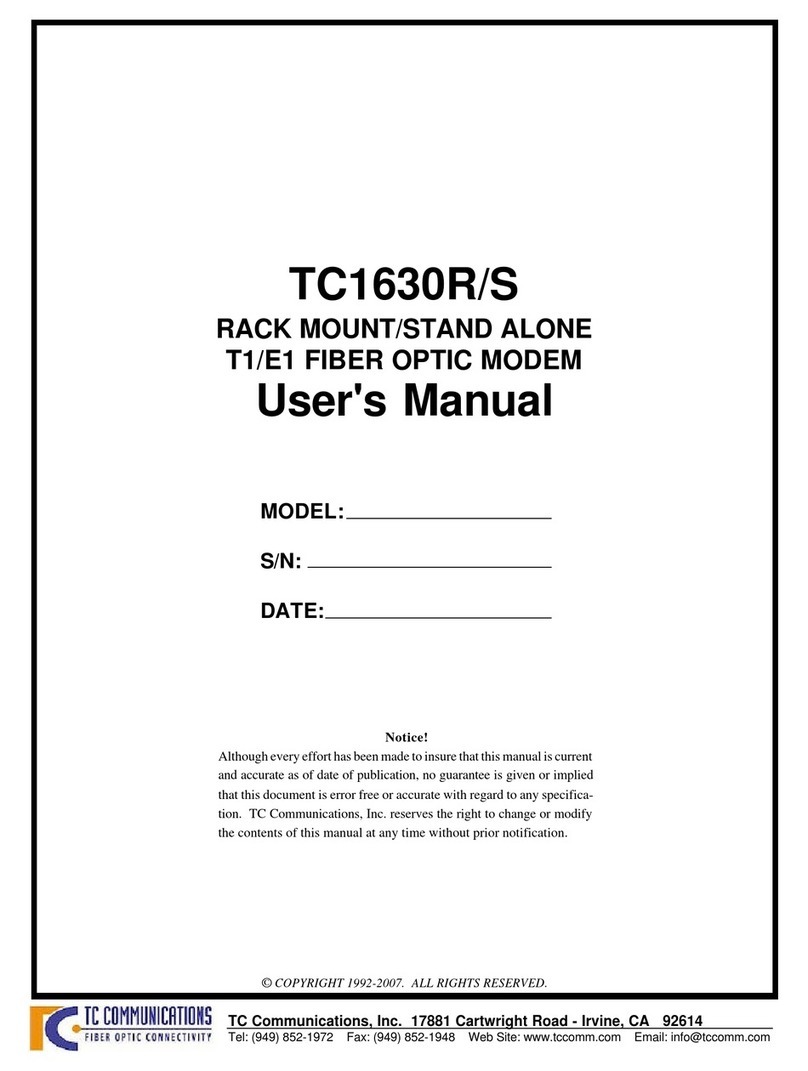
TC Communications
TC Communications TC1630R User manual
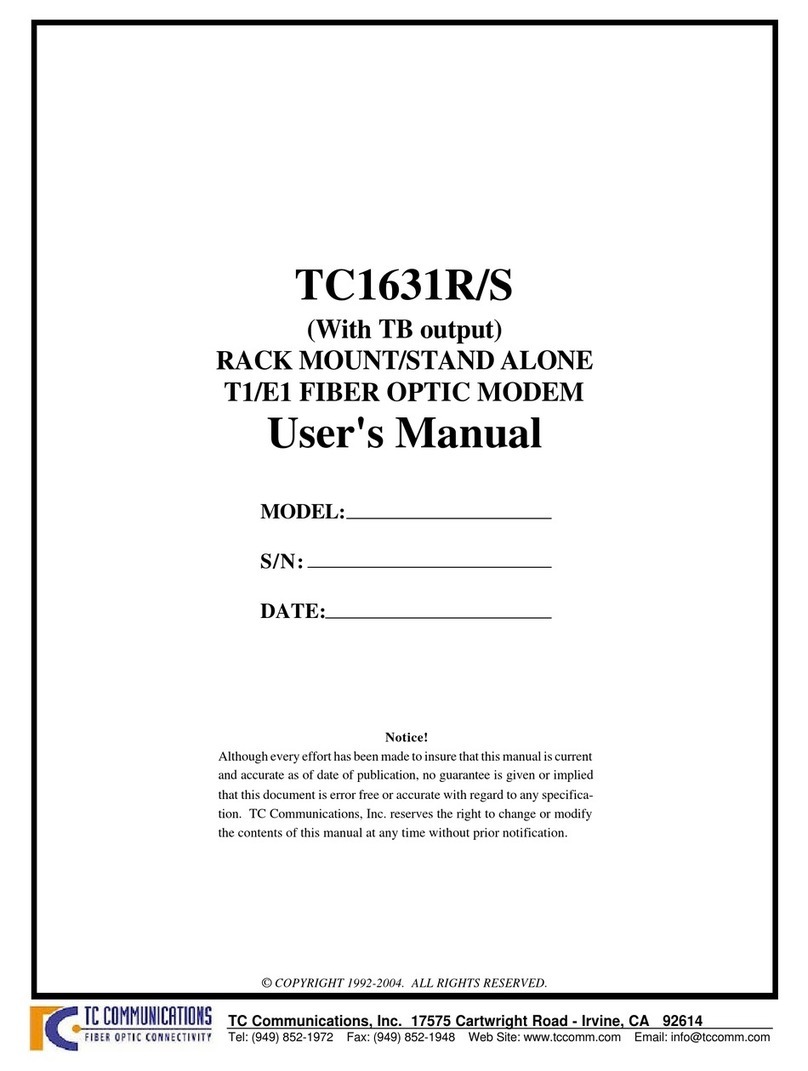
TC Communications
TC Communications TC1631R User manual
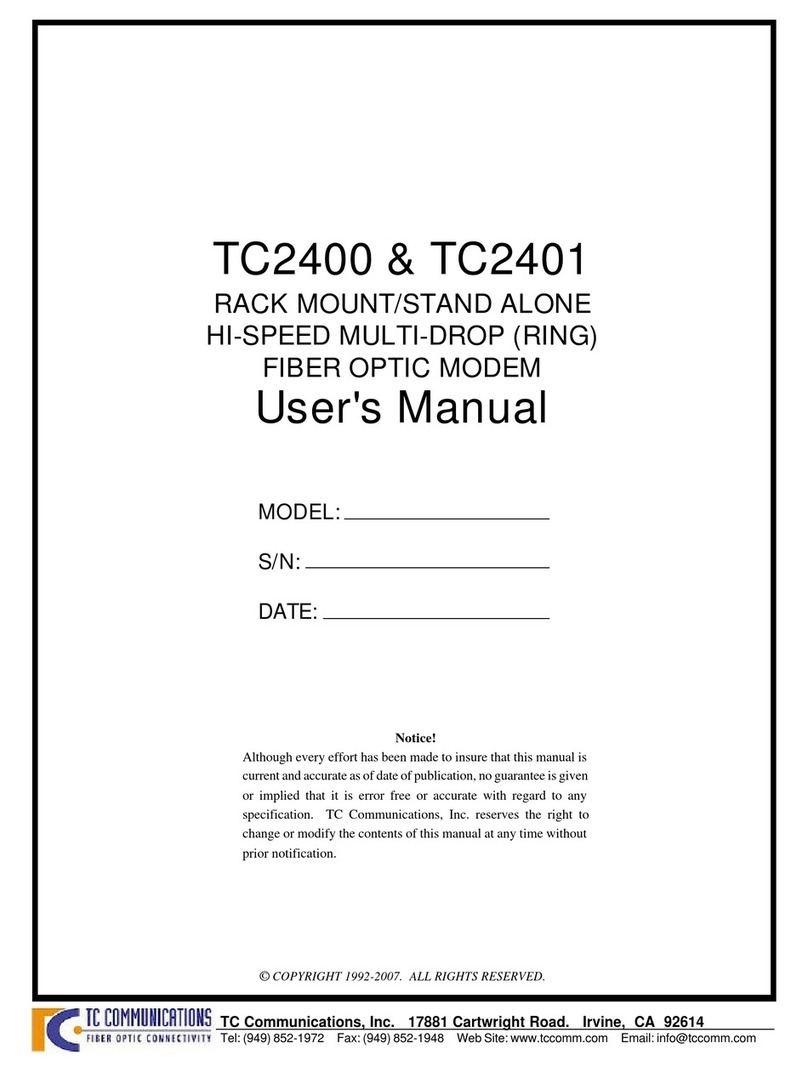
TC Communications
TC Communications TC2400 User manual

TC Communications
TC Communications TC2200R User manual
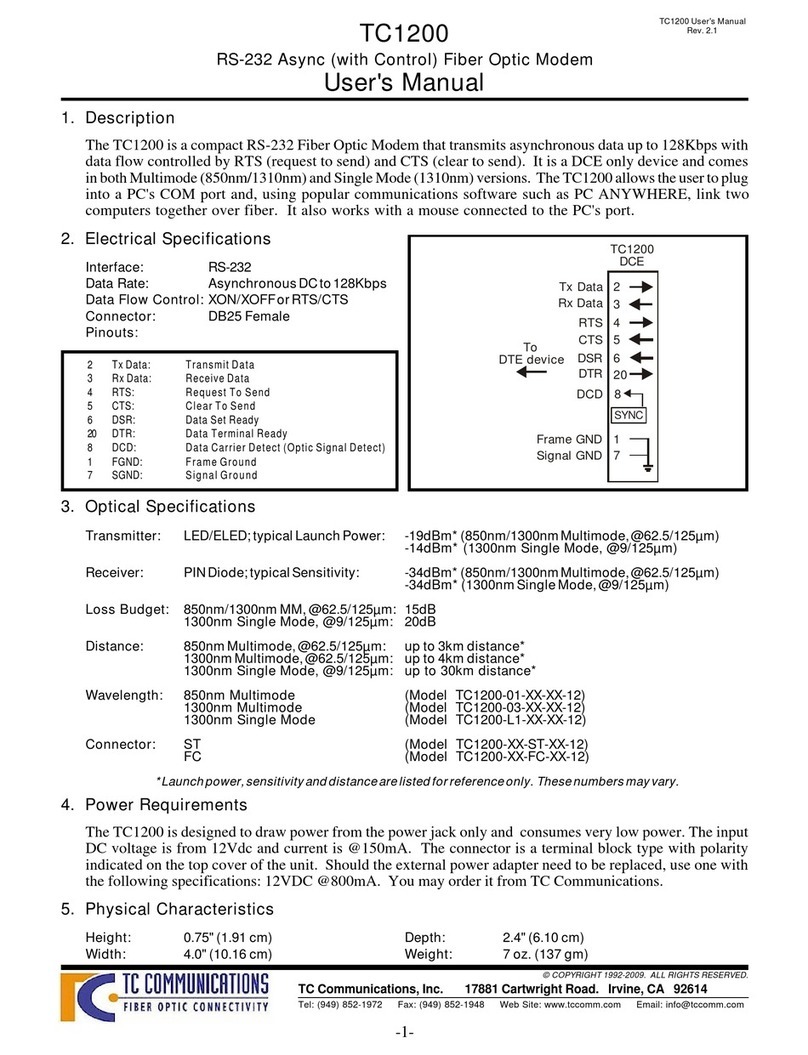
TC Communications
TC Communications TC1200 User manual
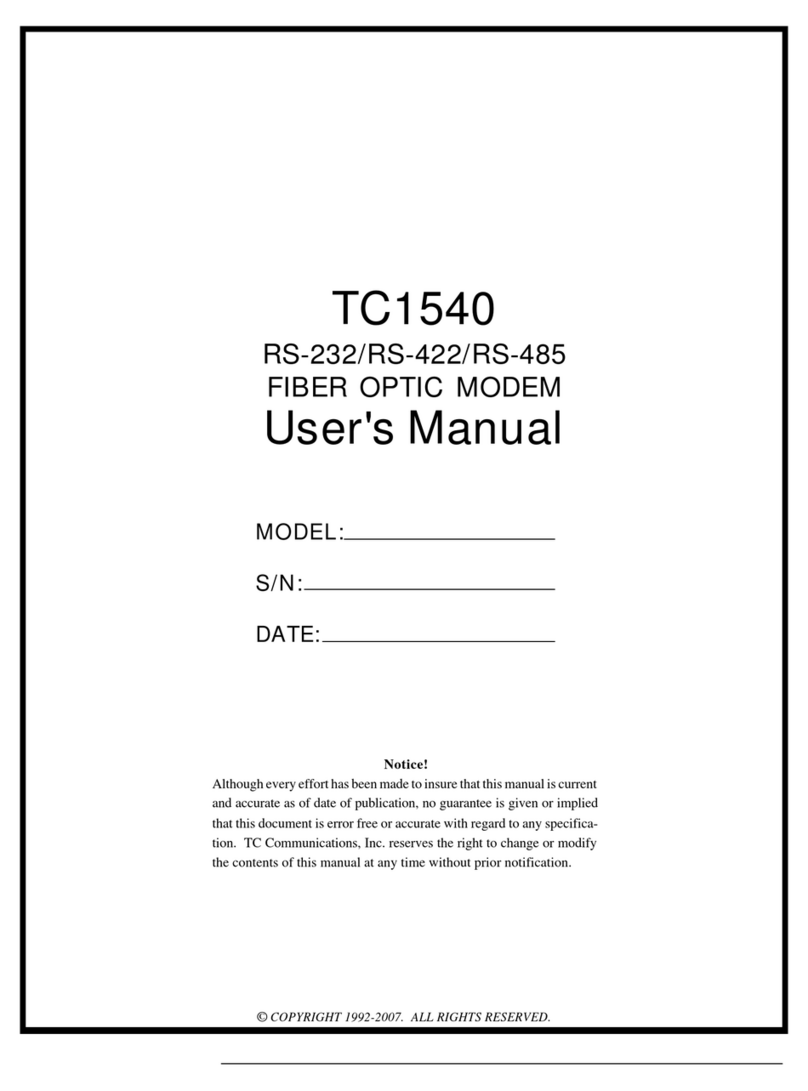
TC Communications
TC Communications TC1540 User manual
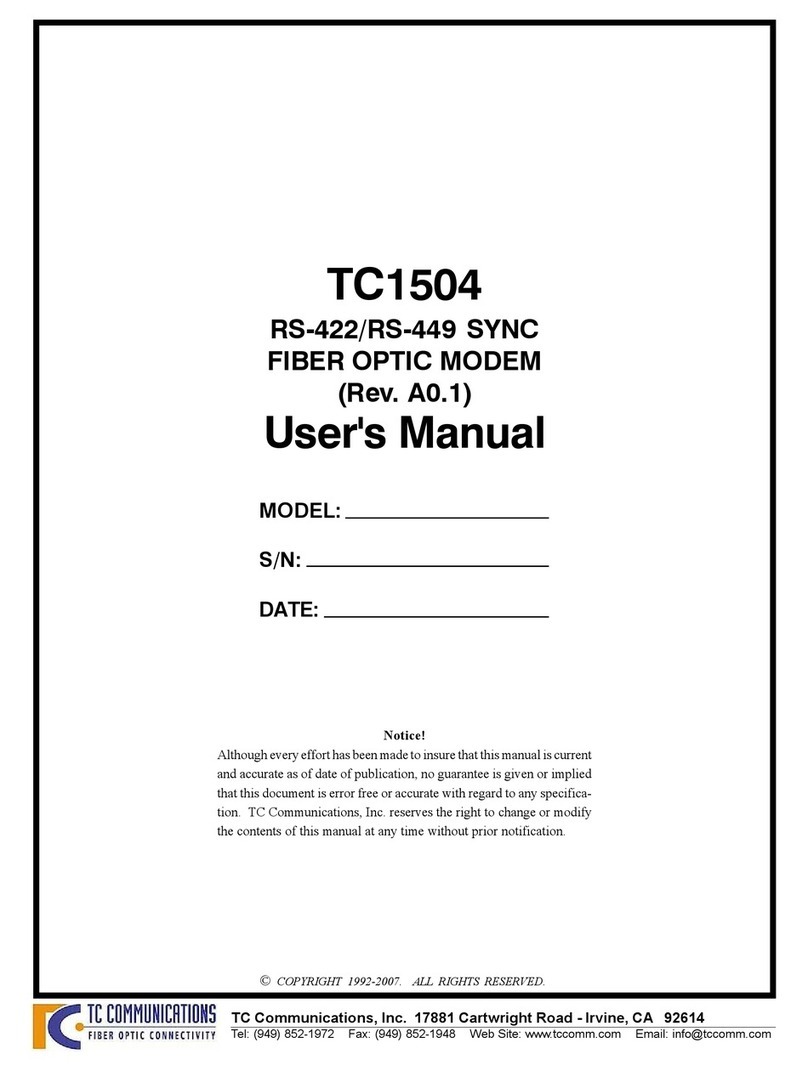
TC Communications
TC Communications TC1504 User manual
